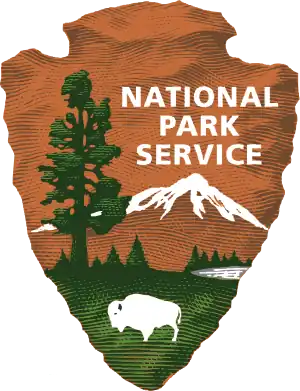Micanopy, Florida | |
|---|---|
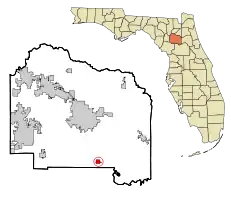 Location in Alachua County and the state of Florida | |
| Coordinates: 29°30′28.95″N 82°16′50.48″W / 29.5080417°N 82.2806889°W | |
| Elevation | 38 m (125 ft) |
| Website | www |
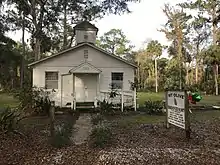
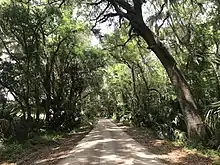
Micanopy (/ˌmɪkəˈnoʊpi/ ⓘ MIK-ə-NOH-pee) is a town in Alachua County, Florida, United States, located south of Gainesville. The population as of the 2010 census was 600.[1] The oldest community in the interior of Florida that has been continually inhabited, it has a downtown that is designated as the Micanopy Historic District and listed on the National Register of Historic Places. It contains a number of antique stores, as well as several restaurants, a library, firehouse, and post office. The town's unofficial slogan is "The Town that Time Forgot."
History
A historical marker in the area notes that Spanish explorer Hernan De Soto recorded finding a village of the Timucua portion of the Potano tribe located near by in 1539.[2] In 1774 the American naturalist William Bartram recorded his impressions of a proto-Seminole village named Cuscowilla.[3]
By the time Spain ceded its Florida provinces to the U.S. in 1821, the newly constructed hamlet of Micanopy became the first distinct United States town in the Florida Territory. One of the early settlers of the area was Moses Elias Levy, a wealthy Jewish businessman and philanthropist who was involved in West Indies shipping and other interests. He immigrated to the United States in 1820 and founded "Pilgrimage", the first Jewish communal settlement in the United States located two miles from town.[4]
The village of Micanopy was built under the auspices of the Florida Association of New York (the earliest Florida development corporation, headquartered in Manhattan).[4] Chief Micanopy lived about 60 miles (97 km) south in present-day Sumter County. In 1821, when the territorial village was developed, a faction of Miccosukee Indians lived in the immediate area. The historian C. S. Monaco has suggested that the town was named after Micanopy "to appease the chief and acknowledge his original authority over the land."[4] In the early days, the frontier village was sometimes referred to as "Wantons," after one of the original settlers.[5]
Both Fort Defiance (1835–1836) and Fort Micanopy (1837–1843) were located here during the Second Seminole War.[3] Some of the bloodiest battles of that war took place along the road southwest from Fort Micanopy to Fort Wacahoota, just inside modern Alachua County.[6] A recent archaeological study has verified both forts as well as the location of two battlefields within the town limits: the Battle of Micanopy and the Battle of Welika Pond (1836).
Prior to the 1880s, produce from Micanopy, including citrus, was carried to the southern shore of Lake Alachua and taken by boat to the northern shore, which was served by branch lines from the Transit Railroad. In 1883, the Florida Southern Railway built a branch line to Micanopy from its line running from Rochelle (southeast of Gainesville) to Ocala. In 1895, a rail line was laid from Micanopy by the Gainesville and Gulf Railroad, and by 1889 reached to Irvine and Fairfield in Marion County, and Sampson City in Bradford County, where it connected to the Atlantic, Suwannee River and Gulf Railway and the Georgia Southern and Florida Railroad.[7] The railroads spurred farming in the surrounding area. It had a population of over 600 in 1880. In the 1920s, cars crossed Paynes Prairie on the Micanopy Causeway.[8]
Micanopy's downtown was listed on the National Register of Historic Places in 1983.[3] The home of Marjorie Kinnan Rawlings, where she wrote The Yearling and Cross Creek, is in nearby Cross Creek. The house is operated as a museum.
Demographics
As of the census[9] of 2000, there were 653 people, 302 households, and 172 families residing in the town. The population density was 631.4 inhabitants per square mile (243.8/km2). There were 346 housing units at an average density of 334.6 per square mile (129.2/km2). The racial makeup of the town was 68.30% White, 28.94% African American, 0.61% Native American, 0.31% Asian, 0.31% from other races, and 1.53% from two or more races. Hispanic or Latino of any race were 1.99% of the population.
There were 302 households, out of which 21.5% had children under the age of 18 living with them, 36.8% were married couples living together, 15.6% had a female householder with no husband present, and 43.0% were non-families. 35.4% of all households were made up of individuals, and 12.9% had someone living alone who was 65 years of age or older. The average household size was 2.16 and the average family size was 2.74.
In the town, the population was spread out, with 19.8% under the age of 18, 4.7% from 18 to 24, 29.6% from 25 to 44, 31.7% from 45 to 64, and 14.2% who were 65 years of age or older. The median age was 43 years. For every 100 females, there were 94.9 males. For every 100 females age 18 and over, there were 85.8 males.
The median income for a household in the town was $27,778, and the median income for a family was $38,611. Males had a median income of $30,938 versus $20,294 for females. The per capita income for the town was $20,433. About 3.0% of families and 15.7% of the population were below the poverty line, including 17.8% of those under age 18 and 21.3% of those age 65 or over.
Education
Micanopy is served by the School Board of Alachua County. The School Board charters two schools,[10] the Micanopy Area Cooperative School (elementary),[11] and Micanopy Academy (secondary).[12]
The Alachua County Library District operates a branch library in the town.[13]
Culture
Micanopy hosts an annual autumn art festival, in which both local and nonlocal artists participate.
Micanopy Historical Society Museum, housed downtown in the Thrasher Warehouse, features displays of local and town history that range from the early Native Americans, to naturalist William Bartram’s travels in the region, to the Seminole Wars and the Civil War. Built in 1896, the warehouse was served by a branch of the Atlantic Coast Line Railroad until the 1950's and was placed on the National Register of Historic Places in 1983.
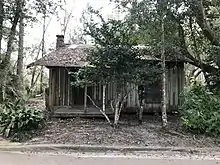
The town hosts a sub-committee of the Alachua County Truth and Reconciliation Initiative. The Initiative seeks to demonstrate how local government can recall its role in historical racial injustice and make all possible amends through official apologies and appropriate reparations.[14] Alachuha county has the highest number of lynchings in Florida.[15] Part of its reconciliation process is a ten-step procedure, after which the county aims to request official recognition from the Equal Justice Initiative's Community Remembrance Project at the National Memorial for Peace and Justice in Montgomery, Alabama. [15] To this end, Micanopy held a Community Remembrance Project. Soil was collected from each location where a local citizen had been executed without due process. It was placed in pairs of glass jars at a ceremony to preserve the memory of the people lost and the justice denied them.[16] The each pair of jars bear the name of one of the victims of injustice and one jar of each pair was sent to the memorial in Montgomery, Alabama.
In June 2023, Mayor Jiana Williams led the Micanopy Town Commission in voting unanimously, and for the first time in its history, to “Recognize June as Pride Month.” The proclamation seeks to celebrate the “equality, inclusivity, and… diversity of our community” and “affirm the principles of dignity, respect, and the right to live authentically without fear of discrimination for all individuals, regardless of sexual orientation or gender identity."[17]

Micanopy lies near several nature preserves. Adjacent to the north, Paynes Prairie Preserve State Park is a Florida State Park encompassing a 21,000-acre savanna. The 600-acre Tuscawilla Preserve, adjacent to Micanopy on its southeast, includes a prairie and uplands with small creeks and mesic forests. Adjacent to Miscanopy's northeast is the Native American Heritage Preserve, where a marker commemorates the old Seminole village of Cuscowilla which was once located within the preserve.[18] Barr Hammock Preserve, to the northwest of Micanopy, is intended for horseback riding, cycling and hiking, with miles of trails contained in its 5,700 acres for these purposes.
In popular culture
Micanopy is mentioned in the Tom Petty song "A Mind with a Heart of Its Own" from the album Full Moon Fever. Petty sings that he's "been to Brooker, been to Micanopy, been to St. Louis too, I've been all around the world!".
In Tony Harrison’s "A Kumquat for John Keats", the great British poet and playwright weaves together the threads of his own life, those of Keats and the taste and sensation of eating kumquats in Micanopy, where he lived in 1979.
"and if John Keats had only lived to be,
because of extra years, in need like me,
at 42 he'd help me celebrate
that Micanopy kumquat that I ate ..."
Micanopy is noted in the chorus of the John Anderson[19] song "Seminole Wind" from the album Seminole Wind. The song is covered by James Taylor on the album James Taylor Covers.
The film Doc Hollywood, based on the book What, Dead Again? by Neil B. Shulman and starring Michael J. Fox, was filmed in Micanopy.[20]
Notable people
- Archie Carr, zoologist and author, and his wife Marjorie Harris Carr, also a conservationist. They lived at Wewa Pond just outside Micanopy[21]
- Stephen F. Eisenman, art historian, critic, columnist (Counterpunch) and environmentalist [22]
- John Horse, Black Seminole leader, lived here before the Seminole Wars and removal to Indian Territory
- Moses Elias Levy, wealthy businessman and philanthropist, founded Pilgrimage and Micanopy[23]
- River Phoenix, actor, cremated ashes scattered here at family ranch
Gallery
Micanopy Historic District
 Herlong House, now a hotel
Herlong House, now a hotel Simonton House
Simonton House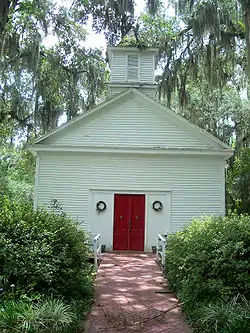 Presbyterian Church, now Episcopal Church of the Mediator
Presbyterian Church, now Episcopal Church of the Mediator Old Baptist Church, now a private house
Old Baptist Church, now a private house City hall and library
City hall and library
See also
References
- ↑ "Geographic Identifiers: 2010 Demographic Profile Data (G001): Micanopy town, Florida". U.S. Census Bureau, American Factfinder. Archived from the original on February 12, 2020. Retrieved May 6, 2013.
- ↑ "Florida Historical Markers Programs - Marker: Alachua - Preservation - Florida Division of Historical Resources". Florida Historical Markers Programs. Archived from the original on December 1, 2023. Retrieved December 1, 2023.
- 1 2 3 "National Register of Historic Places Inventory -- Nomination Form" (PDF). National Parks Service. September 28, 1983. Archived from the original on June 8, 2021. Retrieved December 1, 2023.
- 1 2 3 C. S. Monaco, Moses Levy of Florida: Jewish Utopian and Antebellum Reformer, Baton Rouge: Louisiana State University Press, 2005), 9
- ↑ "Micanopy Historical Marker". www.hmdb.org. Archived from the original on December 1, 2023. Retrieved December 1, 2023.
- ↑ Monaco, C. S. (2012). "Alachua Settlers and the Second Seminole War". The Florida Historical Quarterly. 91 (1): 1–32. ISSN 0015-4113.
- ↑ Watkins, Caroline (April 1975). "Some Early Railroads in Alachua County". The Florida Historical Quarterly. 53 (4): 452–453, 456. JSTOR 30150300.
- ↑ Pickard, John B. (2001). Historic Alachua County and old Gainesville : a tour guide to the past. Gainesville, FL: Alachua Press. ISBN 978-0967278865. OCLC 50765140.
- ↑ "U.S. Census website". United States Census Bureau. Retrieved January 31, 2008.
- ↑ Alachua County Public Schools: Schools and Centers Archived December 17, 2011, at the Wayback Machine
- ↑ "Contact MACS." Micanopy Area Cooperative School. Retrieved on September 24, 2018. "Address 802 NW Seminary St., Micanopy, FL 32667"
- ↑ Home. Micanopy Academy. Retrieved on September 24, 2018. "708 NW Okehumkee St. Micanopy, FL 32667"
- ↑ Alachua County Library District: Micanopy
- ↑ "Alachua County Truth and Reconciliation". truth.alachuacounty.us. Retrieved February 21, 2022.
- 1 2 Escalante, Ana (February 8, 2020). "Alachua County Advances Truth And Reconciliation Process With Memorial For Lynching Victims". WUFT News. Archived from the original on December 1, 2023. Retrieved December 2, 2023.
- ↑ Dimilta, Anissa (May 23, 2022). "Micanopy and Wacahoota lynching victims memorialized with soil collection ceremony". WUFT News. Archived from the original on December 1, 2023. Retrieved December 2, 2023.
- ↑ "Town Commission - Regularly Scheduled Meeting". TownCloud. June 13, 2023.
- ↑ Micanopy Trust for Historical Forts and Battlefields (May 25, 2020) [2017]. Seminole Heritage in Micanopy (Historical marker sign). On Southeast Tuscawilla Road, three tenths of a mile west of U.S. highway four-four-one, on the right when traveling west. Archived from the original on December 2, 2023. Retrieved December 1, 2023.
- ↑ Johnanderson.com
- ↑ IdeCorrespondent, Lora E. "Residents recall the fun of filming 'Doc Hollywood'". Ocala.com. Retrieved January 29, 2019.
- ↑ Archie Carr, "Wewa Pond," in A Naturalist in Florida: A Celebration of Eden, ed. Marjorie Harris Carr (New Haven/London: Yale University Press, 1994), 1–13.
- ↑ Eisenman, Stephen F. (August 19, 2022). "Conversations with White People". CounterPunch.org. Retrieved August 20, 2022.
- ↑ C. S. Monaco, Moses Levy of Florida: Jewish Utopian and Antebellum Reformer, Baton Rouge: Louisiana State University Press, 2005
External links
- Town of Micanopy official website
- Cotton States newspaper that serves Micanopy, Florida is available in full-text with images in Florida Digital Newspaper Library
- Micanopy Branch Library
- Welcome to Micanopy, commercial website
- Micanopy Historical Society
- Article on Micanopy from the Florida Historical Society

